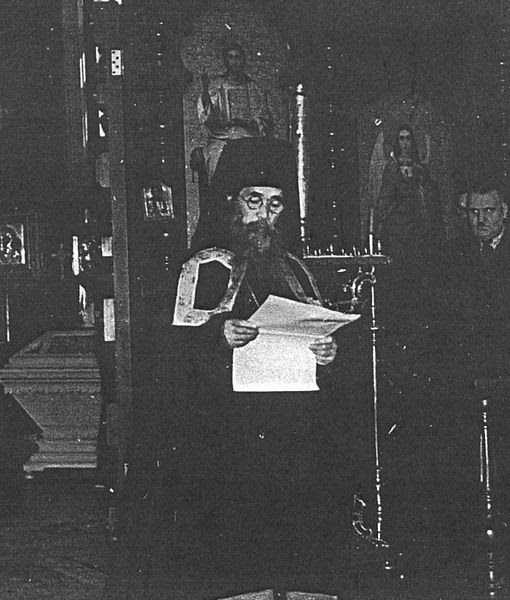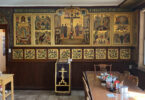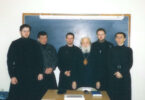On this day in 1941 Bishop Nicholas (Ono) of the ROCOR became the head of Japanese Orthodox Church.
Bishop Sergii (Tikhomirov) was appointed to Japan in 1908 as the successor of the renowned Enlightener of Japan, Equal of the Apostles Nicholas. Bishop Sergii was gentle and modest and a devoted supporter of Vladika Nicholas until his passing away. In his appearance, Bishop Sergii resembled a scholar with refined aristocratic features. Both hierarchs understood the missionary mission in Japan in the same manner. According to contemporaries Vladyka Nicholas considered opinions of a very few Russians and Bishop Sergii was among them. Notwithstanding the fact that they differed greatly in character, Vladika Nicholas always confided in his assistant and spoke of him fondly.
The Japanese Mission enjoyed some thriving periods but also endured severe crises. It is generally believed that the Russian revolution of 1917 and the earthquake of 1923 in the Kantō region were the major events that triggered the decline of the Orthodox Church in Japan. However, the causes behind the declining authority of Orthodoxy in Japan are far more complex.
Archbishop Sergii (Tikhomirov) was elevated to the rank of metropolitan by a decree issued by Metropolitan Sergii (Stragorodskii), Deputy Patriarchal Locum Tenens, in 1931.
The situation in Japan was turbulent. The nationalistic and militaristic sentiments were spreading fast. This manifestation was reflected in Japan’s economic and aggressive military policies for China.
In 1939 Japan’s Parliament introduced a law prescribing all of the country’s religious organizations to register by April 1941 as a legal entity with the Ministry of Education. However, the Orthodox Church, due to the paucity of its parishioners, was not registered as a legal entity but simply as a religious group. Furthermore, rules governing the registration process forbade foreigners from assuming the governance of a religious community. Metropolitan Sergii (Tikhomirov) was hence deprived of the leadership of the Japanese Orthodox community since he refrained from adopting Japan’s citizenship. With the blessing of Metropolitan Sergii, during the Council of the Orthodox Church held in Tokyo in July 1940, the administration of the Japanese Church was temporarily transferred to Arsenii Iwasawa, a Japanese layperson. A Japanese bishop was to be elected in due time.
Metropolitan Sergii remained in the Mission’s residence from September 1940 to January 1942. The Japanese parishioners asked him to assist in the Church’s management. However, due to the rising conflicts and hostilities amid the clergy, Vladika Sergii was forced to move into the former residence of the Anglican Mission in Tokyo’s Setagaya neighborhood, where he began conducting services attended by the Russian community and a few Japanese faithful. Metropolitan Sergii provided spiritual guidance to more than four thousand believers, conducting services on his own, without any support from either priests or deacons.
Back in 1937, certain individuals and orthodox members of the clergy in Yokohama tabled a proposal of a reform of the Orthodox Church in Japan. This marked the beginning of Metropolitan Sergii’s criticism and a pretext for excluding him from participating in the life of the Orthodox community. The supporters of this movement count many influential people, including a “Russian Group” formed in the headquarters of Japan’s Army for the potential use of the Orthodox Church in Siberia in case of the Japanese successful expansion in the Far East.
Toward the end of 1940 Japanese orthodox communities began calling for the organization of a council consisted of clergy and laity. However, Arsenii Iwasawa did not approve such a council. The Japanese parishes gathered at a spontaneous council on January 1941 and removed Iwasawa from his office at the Orthodox Church. The governance was temporarily transferred to Archpriest James Shintaro Tohei from Osaka. By early 1941, two major groups emerged from all of the conflicting factions – one headed by Arsenii Iwasawa and the other by James Tohei.
Arsenius Iwasawa, as a layman, could not become the primate of the Orthodox Church in Japan, and hence the group brought forward Archpriest John Kiichi Ono as a candidate for episcopal consecration. Since the civil authorities prioritized the rapprochement of the Japanese Church with the Russian Orthodox Church Outside Russia (ROCOR), contact was established with Metropolitan Anastasii (Gribanovskii), First Hierarch of the Russian Church Abroad. The episcopal consecration of the first Japanese bishop was to be held in the pro-Japanese puppet state of Manchukuo. John Ono took monastic vows with the name Nicholas. On March 14, 1941, the hierarchs of the ROCOR, headed by Metropolitan Meletii of Harbin and Manchuria (Zaborovsky) consecrated Bishop F. John (Ono) a bishop.
However, on the Easter of 1941, the faithful that rejected the Russian Church Abroad, locked the gates of the Cathedral of the Resurrection of Christ in Tokyo and did not admit Bishop Nicholas (Ono) and his Japanese following onto the premises, and consequently, there was no service at the cathedral. The Easter service was held at the deacon’s home.
The parishes gradually assembled under the governance of Vladika Nicholas (Ono). In the summer of 1941, the Ministry of Education issued a fixed and incontestable decision that the Japanese Orthodox were to recognize Bishop Nicholas as the head of the Church. The authorities offered as a compromise, to consecrate Archpriest John Tokhei a bishop, to alternate between the two bishops church governance on annual terms. ROCOR’s hierarchs agreed to the episcopal consecration of Fr. James Tokhei. However, Harbin’s military authorities declared that no consecration was to be officiated until the end of the war.
Bishop Nicholas (Ono) conceded on many occasions for the misappropriation of the Church’s property. A church building used by the Mission during cold season was leased. Vladika Nicholas opened an English language school there, which he formally managed and where he received a salary. The Bishop gave his permission to smoke and sing in the building of the “winter Church,” which raised the indignation of the orthodox Christians – many of them stopped attending the Church. An investigation was initiated against Bishop Nicholas regarding the misappropriation of the Church’s property. All of the Church bank accounts were frozen. As a result, the court banned Vladika Nicholas from taking part in the Church’s governance.
Nevertheless, the Church pursued its everyday life. An organization was founded for raising funds for the government; prayers for soldiers were carried out on the first Sunday of each month. With the worsening situation on the front and due to the shortage of food, services were irregular – wine and flour were lacking for the preparation of prosphora. By the end of the war, there were but two priests left. Services were practically halted at the cathedral of the Resurrection of Christ. Since the Church did not have any sources of funding, the Church sold metal fence surrounding the cathedral, and even the roof’s copper was disposed of. In 1945, Tokyo was the target of air raids and bombings, so the cathedral was painted black to avoid being hit.
On April 1945, Metropolitan Sergii (Tikhomirov) was arrested on suspicion of espionage on behalf of the USSR and subjected to torture. The forty days he spent under arrest seriously undermined the health of the 74-year old hierarch. On August 10, 1945, a day after the nuclear attack on Nagasaki, Vladika passed away alone in a small apartment in Itabashi, a Tokyo suburb. The funeral took place in the only remaining building of central Tokyo, which survived the American bombings and fires – the Nikorai-do Cathedral. Vladika Sergii (Tikhomirov) is buried in the Yanaka cemetery, next to the grave of Saint Nicholas of Japan.
Archpriest Dionysii Pozdnyaev,
Hong Kong, February 2018
Relevant Resources:











